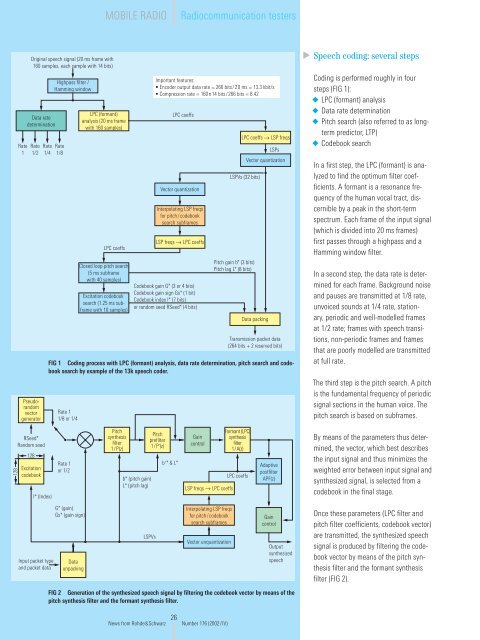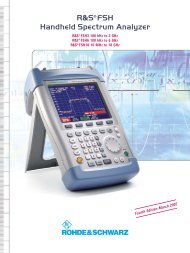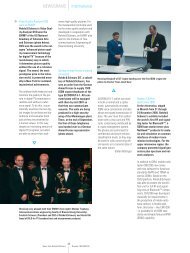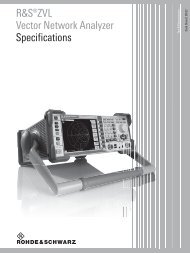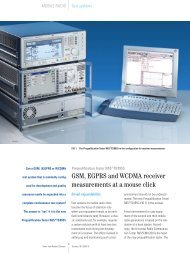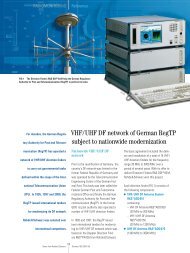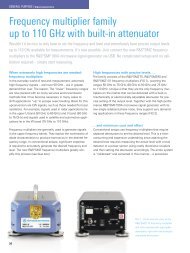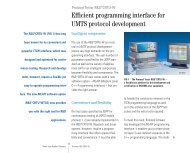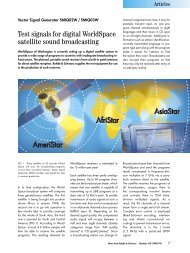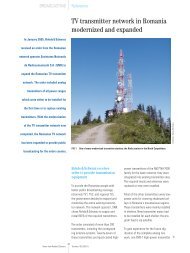English - Rohde & Schwarz
English - Rohde & Schwarz
English - Rohde & Schwarz
Create successful ePaper yourself
Turn your PDF publications into a flip-book with our unique Google optimized e-Paper software.
MOBILE RADIO<br />
Radiocommunication testers<br />
Rate<br />
1<br />
Original speech signal (20 ms frame with<br />
160 samples, each sample with 14 bits)<br />
Data rate<br />
determination<br />
Rate<br />
1/2<br />
Pseudorandom<br />
vector<br />
generator<br />
Rate<br />
1/4<br />
Highpass filter /<br />
Hamming window<br />
Rate<br />
1/8<br />
LPC (formant)<br />
analysis (20 ms frame<br />
with 160 samples)<br />
LPC coeffs<br />
Closed loop pitch search<br />
(5 ms subframe<br />
with 40 samples)<br />
Excitation codebook<br />
search (1.25 ms subframe<br />
with 10 samples)<br />
Important features:<br />
• Encoder output data rate = 266 bits/20 ms = 13.3 kbit/s<br />
• Compression rate = 160n14 bits/266 bits = 8.42<br />
LPC coeffs<br />
Vector quantization<br />
Interpolating LSP freqs<br />
for pitch/codebook<br />
search subframes<br />
LSP freqs → LPC coeffs<br />
Codebook gain G* (3 or 4 bits)<br />
Codebook gain sign Gs* (1 bit)<br />
Codebook index I* (7 bits)<br />
or random seed RSeed* (4 bits)<br />
LPC coeffs → LSP freqs<br />
LSPVs (32 bits)<br />
Pitch gain b* (3 bits)<br />
Pitch lag L* (8 bits)<br />
LSPs<br />
Vector quantization<br />
Data packing<br />
Transmission packet data<br />
(264 bits + 2 reserved bits)<br />
FIG 1 Coding process with LPC (formant) analysis, data rate determination, pitch search and codebook<br />
search by example of the 13k speech coder.<br />
Rate 1<br />
1/8 or 1/4<br />
Speech coding: several steps<br />
Coding is performed roughly in four<br />
steps (FIG 1):<br />
◆ LPC (formant) analysis<br />
◆ Data rate determination<br />
◆ Pitch search (also referred to as longterm<br />
predictor, LTP)<br />
◆ Codebook search<br />
In a first step, the LPC (formant) is analyzed<br />
to find the optimum filter coefficients.<br />
A formant is a resonance frequency<br />
of the human vocal tract, discernible<br />
by a peak in the short-term<br />
spectrum. Each frame of the input signal<br />
(which is divided into 20 ms frames)<br />
first passes through a highpass and a<br />
Hamming window filter.<br />
In a second step, the data rate is determined<br />
for each frame. Background noise<br />
and pauses are transmitted at 1/8 rate,<br />
unvoiced sounds at 1/4 rate, stationary,<br />
periodic and well-modelled frames<br />
at 1/2 rate; frames with speech transitions,<br />
non-periodic frames and frames<br />
that are poorly modelled are transmitted<br />
at full rate.<br />
The third step is the pitch search. A pitch<br />
is the fundamental frequency of periodic<br />
signal sections in the human voice. The<br />
pitch search is based on subframes.<br />
128<br />
RSeed*<br />
Random seed<br />
128<br />
Excitation<br />
codebook<br />
I* (Index)<br />
Rate 1<br />
or 1/2<br />
Pitch<br />
synthesis<br />
filter<br />
1/P(z)<br />
b* (pitch gain)<br />
L* (pitch lag)<br />
Pitch<br />
prefilter<br />
1/P'(z)<br />
b'* & L*<br />
Gain<br />
control<br />
LSP freqs → LPC coeffs<br />
Formant (LPC)<br />
synthesis<br />
filter<br />
1/A(z)<br />
LPC coeffs<br />
Adaptive<br />
postfilter<br />
APF(z)<br />
By means of the parameters thus determined,<br />
the vector, which best describes<br />
the input signal and thus minimizes the<br />
weighted error between input signal and<br />
synthesized signal, is selected from a<br />
codebook in the final stage.<br />
Input packet type<br />
and packet data<br />
G* (gain)<br />
Gs* (gain sign)<br />
Data<br />
unpacking<br />
LSPVs<br />
Interpolating LSP freqs<br />
for pitch/codebook<br />
search subframes<br />
Vector unquantization<br />
Gain<br />
control<br />
Output<br />
synthesized<br />
speech<br />
Once these parameters (LPC filter and<br />
pitch filter coefficients, codebook vector)<br />
are transmitted, the synthesized speech<br />
signal is produced by filtering the codebook<br />
vector by means of the pitch synthesis<br />
filter and the formant synthesis<br />
filter (FIG 2).<br />
FIG 2 Generation of the synthesized speech signal by filtering the codebook vector by means of the<br />
pitch synthesis filter and the formant synthesis filter.<br />
News from <strong>Rohde</strong>&<strong>Schwarz</strong><br />
26<br />
Number 176 (2002/IV)


